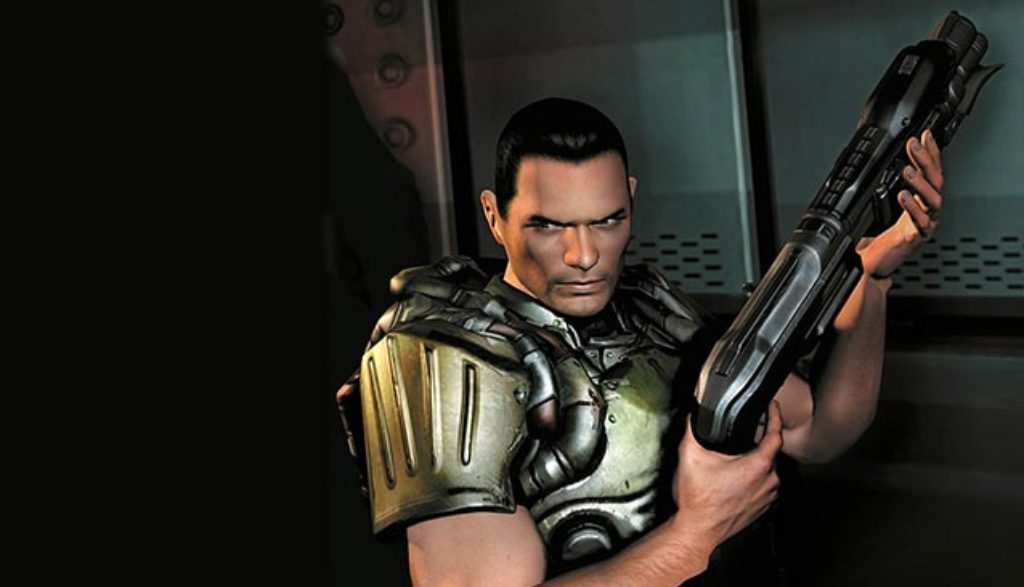
“You will die, and your soul will be mine.” “I will bring hell to earth.” “Death will not be your end. Your soul will burn in hell forever.”
Lines of dialogue from the latest Hollywood horror flick? These ghoulish threats are from one of the most breathlessly awaited releases of the year. But it’s not a movie. It’s a video game.
Doom 3 is the latest blockbuster in a genre of video games known as first-person shooters—games played from the perspective of someone holding a weapon and taking on all comers. The original Doom debuted in 1993, and almost single-handedly created a new genre that later gave birth to Quake, Halo and scores of other imitators. But the Doom franchise arguably remains the granddaddy of them all, and players have eagerly awaited the latest installment of this archetypal shooter.
Hell Unleashed
The plot is straightforward—if foreboding—sci-fi. The Union Aerospace Corporation has been doing teleportation experiments on Mars, and they’ve unwittingly opened a gateway to hell. You play a marine sent to the base to close portals to the netherworld. If you fail, a mad scientist named Betruger (“The devil is real. I know—I built his cage”) has promised to unleash demonic wrath on earth.
That may sound like familiar territory for gamers who devoured the first Doom game. This time, however, idSoftware has unveiled a new graphics engine that those in the know have hailed as the most realistic ever. Thus, Doom 3 at times feels less like a video game and more like an interactive movie.
And a terrifying movie it is. Demonic denizens lurk in the darkness, in ventilation shafts and even teleport in from hell to torment you and other unfortunate survivors on the base. Your response? Use a trusty shotgun (and other hand-held weapons) to take them down (as well as already-wounded humans, if you feel like it).
Some of Doom 3‘s most disturbing scenes depict graphic carnage wrought by the demons: a marine impaled on the ceiling, his chest torn open, crying out in fear as an alien-like demon comes for him; a woman whose head explodes as a demon emerges from it; a decapitated torso hung in a metal box with its legs cut off, yet—horrifically—still wriggling. The last level depicts the grisly sight of four disemboweled men crucified upside-down.
It goes without saying, then, that the game is drenched in blood. The first few levels begin with “mere” splatters and blood trails. But as you move deeper into the game, the blood on the walls become more like paint—with messages written in it: “Die. Succumb. Hide.”
These bloody scenes combine ominously with occult symbolism. Pentagrams are ubiquitous, and serve as portals for the denizens of hell to emerge on the Mars base. An intercepted e-mail between demons (yes, there’s e-mail in hell; probably a lot of spam!) offers specific instructions for creating a successful portal, which requires a pentagram drawn with blood (preferably a virgin’s), a disemboweled victim and candles all around.
Augmenting the visual horror of the game are furtive sounds of movement around you, muffled yet desperate pleas for help and continuous taunts and threats from “down there.”
The Media Accentuates the Message
The creators of Doom 3 have outdone themselves in re-birthing a horrifying world with cinematic clarity and effect. Gameplay itself is not revolutionary, but the way programmers have rendered the sights and sounds of this demonic realm is gripping. And it is the “excellence” of this game that makes it so compelling. It has become the new graphic standard by which similar games will be measured.
That makes it one of the “must have” games of the year. And it’s not hard for me to understand the draw that it exerts on players. The experience is a powerful one. But it’s the very allure of this gameplaying experience that leaves me asking some important questions. What effect does nonstop carnage have on devoted (or even casual) players? What about constant exposure to the game’s occult images? Fans may claim, “I don’t really pay attention to all that satanic stuff. It’s just a game.” But how can hours of exposure to vividly rendered, gruesome images of dismemberment, combined with pentagrams and voices from hell not influence someone negatively, especially younger gamers?
Images of zombies eating one another’s entrails—and then coming after you—are the stuff of nightmares. Do we really want to get used to images like these?

After serving as an associate editor at NavPress’ Discipleship Journal and consulting editor for Current Thoughts and Trends, Adam now oversees the editing and publishing of Plugged In’s reviews as the site’s director. He and his wife, Jennifer, have three children. In their free time, the Holzes enjoy playing games, a variety of musical instruments, swimming and … watching movies.